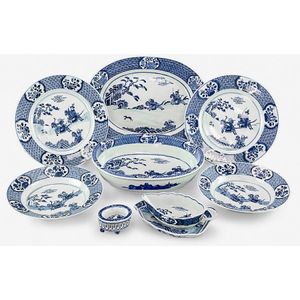Blue Floral Staffordshire Pearlware Serving Dishes/Plates, 1820s
You must be a subscriber, and be logged in to view price and dealer details.
Subscribe Now to view actual auction price for this item
When you subscribe, you have the option of setting the currency in which to display prices to $Au, $US, $NZ or Stg.
- Pearlware - Pearlware is a type of earthenware pottery that was developed in the late 18th century in England, made from a mixture of clay, flint, and other materials, and is distinguished by its smooth, creamy white glaze. The glaze has a pearlescent quality, which is how the pottery got its name.
Pearlware was developed as a more affordable alternative to porcelain, which was much more expensive and difficult to produce. It quickly became popular throughout England and Europe, and was exported to other parts of the world as well. It was particularly popular for making tableware, such as plates, bowls, and teapots, as well as decorative objects like figurines and vases.
One of the most distinctive features of pearlware is its blue decoration. Many pieces of pearlware were decorated with blue patterns or designs, often featuring pastoral scenes, floral motifs, or geometric patterns. The blue decoration was typically applied over the white glaze, which created a striking contrast and made the designs stand out. - Transfer Printed / Decorated Transferware - Transfer printing is method of decorating ceramics, reducing the cost of decoration when compared to employing artists to paint each piece. A print was taken on transfer-paper from an engraved copperplate, covered in ink prepared with metallic oxides, and the image on the paper was then applied to the biscuit-fired ceramic body. The print was fixed by heating the object in an oven, and then glazed, sealing the picture. Early transfer prints were blue and white, as cobalt was the only colour to stand firing without blurring. Early in the 19th century advances in the composition of the transfer paper resulted in better definition and detail, and enabled engravers to combine line-engraving with stipple.
This item has been included into following indexes:
Visually similar items


A Victorian Minton stone china 'Amherst Japan' pattern dinner service, comprising: six dinner plates, six entree plates, six bowls, two covered tureens and three large serving platters, all decorated in the typical maner with jardinieres filled with flower

Chinese export Kangxi-style blue and white partial dinner service, 19th century, including: seven dinner plates, fourteen side plates, two large plates, four deep plates, eight soup plates, one tureen, three graduated oval platters, one gravy boat, one spo

